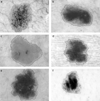Border detection in dermoscopy images using statistical region merging
- PMID: 19159382
- PMCID: PMC3160669
- DOI: 10.1111/j.1600-0846.2008.00301.x
Border detection in dermoscopy images using statistical region merging
Abstract
Background: As a result of advances in skin imaging technology and the development of suitable image processing techniques, during the last decade, there has been a significant increase of interest in the computer-aided diagnosis of melanoma. Automated border detection is one of the most important steps in this procedure, because the accuracy of the subsequent steps crucially depends on it.
Methods: In this article, we present a fast and unsupervised approach to border detection in dermoscopy images of pigmented skin lesions based on the statistical region merging algorithm.
Results: The method is tested on a set of 90 dermoscopy images. The border detection error is quantified by a metric in which three sets of dermatologist-determined borders are used as the ground-truth. The proposed method is compared with four state-of-the-art automated methods (orientation-sensitive fuzzy c-means, dermatologist-like tumor extraction algorithm, meanshift clustering, and the modified JSEG method).
Conclusion: The results demonstrate that the method presented here achieves both fast and accurate border detection in dermoscopy images.
Figures



Similar articles
-
Unsupervised border detection in dermoscopy images.Skin Res Technol. 2007 Nov;13(4):454-62. doi: 10.1111/j.1600-0846.2007.00251.x. Skin Res Technol. 2007. PMID: 17908199 Free PMC article.
-
Approximate lesion localization in dermoscopy images.Skin Res Technol. 2009 Aug;15(3):314-22. doi: 10.1111/j.1600-0846.2009.00357.x. Skin Res Technol. 2009. PMID: 19624428 Free PMC article.
-
Objective evaluation of methods for border detection in dermoscopy images.Annu Int Conf IEEE Eng Med Biol Soc. 2008;2008:3056-9. doi: 10.1109/IEMBS.2008.4649848. Annu Int Conf IEEE Eng Med Biol Soc. 2008. PMID: 19163351
-
Fast density-based lesion detection in dermoscopy images.Comput Med Imaging Graph. 2011 Mar;35(2):128-36. doi: 10.1016/j.compmedimag.2010.07.007. Epub 2010 Sep 17. Comput Med Imaging Graph. 2011. PMID: 20800995
-
Lesion border detection in dermoscopy images.Comput Med Imaging Graph. 2009 Mar;33(2):148-53. doi: 10.1016/j.compmedimag.2008.11.002. Epub 2009 Jan 3. Comput Med Imaging Graph. 2009. PMID: 19121917 Free PMC article. Review.
Cited by
-
Cancer Diagnosis Using Deep Learning: A Bibliographic Review.Cancers (Basel). 2019 Aug 23;11(9):1235. doi: 10.3390/cancers11091235. Cancers (Basel). 2019. PMID: 31450799 Free PMC article. Review.
-
Automatic detection of basal cell carcinoma using telangiectasia analysis in dermoscopy skin lesion images.Skin Res Technol. 2011 Aug;17(3):278-87. doi: 10.1111/j.1600-0846.2010.00494.x. Epub 2011 Mar 29. Skin Res Technol. 2011. PMID: 23815446 Free PMC article.
-
Segmentation of skin lesion using Cohen-Daubechies-Feauveau biorthogonal wavelet.Springerplus. 2016 Sep 19;5(1):1603. doi: 10.1186/s40064-016-3211-4. eCollection 2016. Springerplus. 2016. PMID: 27652176 Free PMC article.
-
Medical Image Segmentation with Learning Semantic and Global Contextual Representation.Diagnostics (Basel). 2022 Jun 25;12(7):1548. doi: 10.3390/diagnostics12071548. Diagnostics (Basel). 2022. PMID: 35885454 Free PMC article.
-
Computer aided diagnostic support system for skin cancer: a review of techniques and algorithms.Int J Biomed Imaging. 2013;2013:323268. doi: 10.1155/2013/323268. Epub 2013 Dec 23. Int J Biomed Imaging. 2013. PMID: 24575126 Free PMC article. Review.
References
-
- Jemal A, Siegel R, Ward E, Murray T, Xu J, Thun MJ. Cancer Statistics 2007. Cancer J Clin. 2007;57:43–66. - PubMed
-
- Menzies SW, Crotty KA, Ingwar C, McCarthy WH. An atlas of surface microscopy of pigmented skin lesions: dermoscopy. Sydney, Australia: McGraw-Hill; 2003.
-
- Steiner K, Binder M, Schemper M, Wolff K, Pehamberger H. Statistical evaluation of epiluminescence dermoscopy criteria for melanocytic pigmented lesions. J Am Acad Dermatol. 1993;29:581–588. - PubMed
-
- Binder M, Schwarz M, Winkler A, Steiner A, Kaider A, Wolff K, Pehamberger H. Epiluminescence microscopy. A useful tool for the diagnosis of pigmented skin lesions for formally trained dermatologists. Arch Dermatol. 1995;131:286–291. - PubMed
-
- Fleming MG, Steger C, Zhang J, Gao J, Cognetta AB, Pollak I, Dyer CR. Techniques for a structural analysis of dermatoscopic imagery. Comput Med Imaging Graphics. 1998;22:375–389. - PubMed
Publication types
MeSH terms
Grants and funding
LinkOut - more resources
Full Text Sources
Other Literature Sources
Medical
Research Materials

